#pearly everlasting
Text

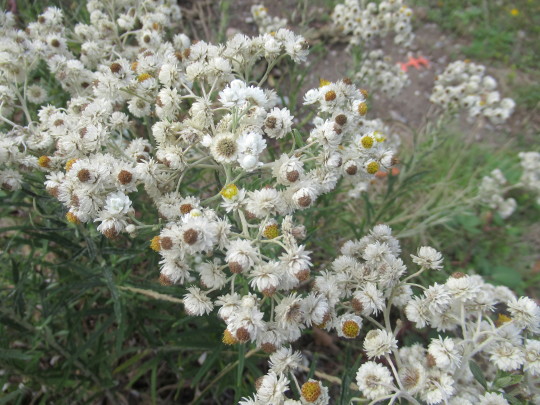
Anaphalis margaritacea (Western pearly everlasting)
There are over 100 species of Anaphalis but only Anaphalis margaritacea is native to North America. It is widespread across most of Canada, the United States and Northwestern Mexico. This species also has native, wild populations throughout Europe and the the Far East. This healthy specimen was found growing on an empty building site. Just what this plant loves: full sun and poor soil.
Western pearly everlasting is dioecious, meaning that the pollen-producing (male) and seed-producing (female) flowers are borne on separate plants. The flowers are either entirely staminate (producing pollen) or functionally pistillate (mostly producing just seed, but with a few staminate flowers present). Thus the female flowers have a brilliant 'back-up plan' which ensures that, even if there are no male plants in the vicinity, there is still a way to produce the next generation of Western pearly everlasting.
#flowers#photographers on tumblr#pearly everlasting#native plants#dried flower arrangements#fleurs#flores#fiori#blumen#bloemen#Vancouver
104 notes
·
View notes
Text
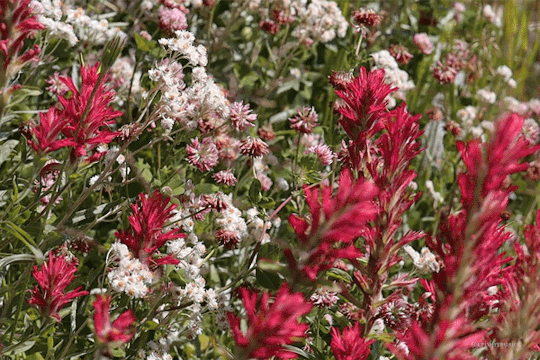
Color Burst
(c) gif by riverwindphotography, August 2023
398 notes
·
View notes
Text
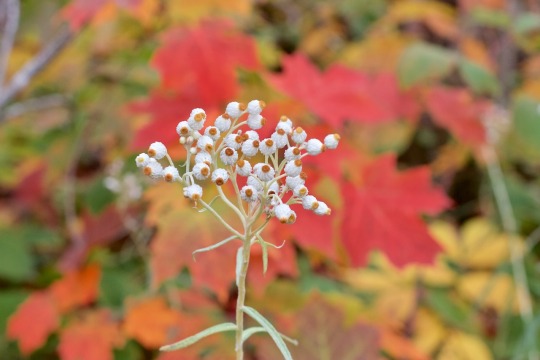
“Unable are the loved to die, for love is immortality.” ~ Emily Dickinson
The pearly everlasting flowers last so long that they have become a symbol of Immortality, and the plant has several other suggestive names including Live-ever, Life-everlasting, and Immortelle. It was traditionally used to decorate the graves of departed loved ones.
39 notes
·
View notes
Text

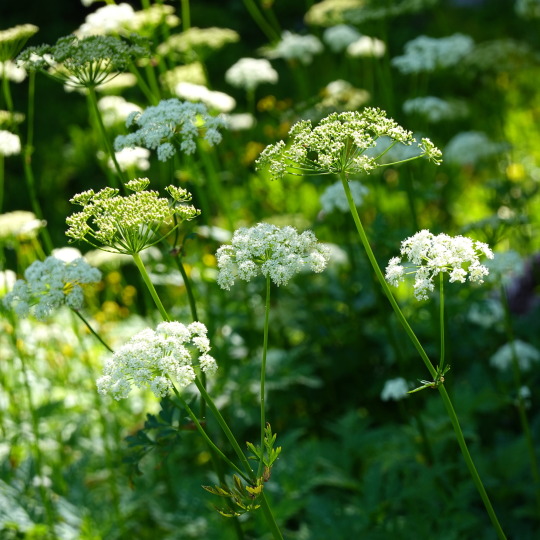
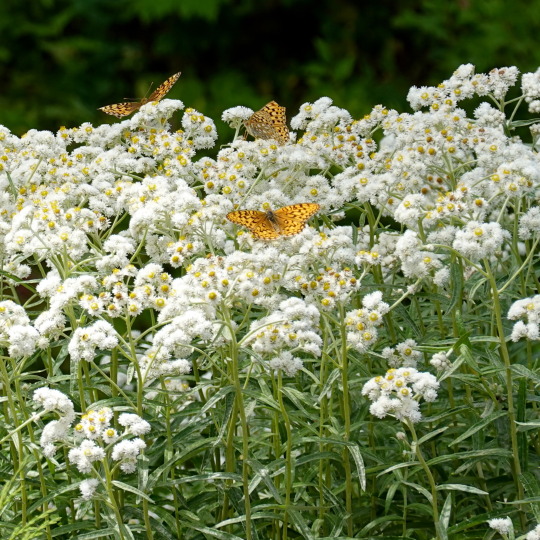
Many wildflower plants are making the shift from blooms to seedheads or berries in the subalpine meadows, but some late-season wildflowers can still be found. Mountain bog gentian (Gentiana calycosa) is having a big year in subalpine meadows around Paradise as well as at Mowich Lake. Other common late-season wildflowers include pearly everlasting and fireweed.
Remember to please stay on trail! It doesn’t take many steps to trample the wildflowers you are coming to see. Many trails offer great opportunities for that perfect mountain + wildflower photo. Where are you finding wildflowers?
For updates on what’s blooming where visit https://go.nps.gov/RainierWildflower
Unfamiliar with Mount Rainier’s wildflower species? Check out the wildflower guide at https://go.nps.gov/RainierWildflowerGuide
NPS Photos of mountain bog gentian at Paradise, 8/16/23, and gray’s lovage and pearly everlasting at Mowich Lake, 8/17/23.
#Rainier Wildflowers#mount rainier national park#wildflowers#mountain bog gentian#pearly everlasting#Paradise#gray's lovage#Mowich Lake
23 notes
·
View notes
Text
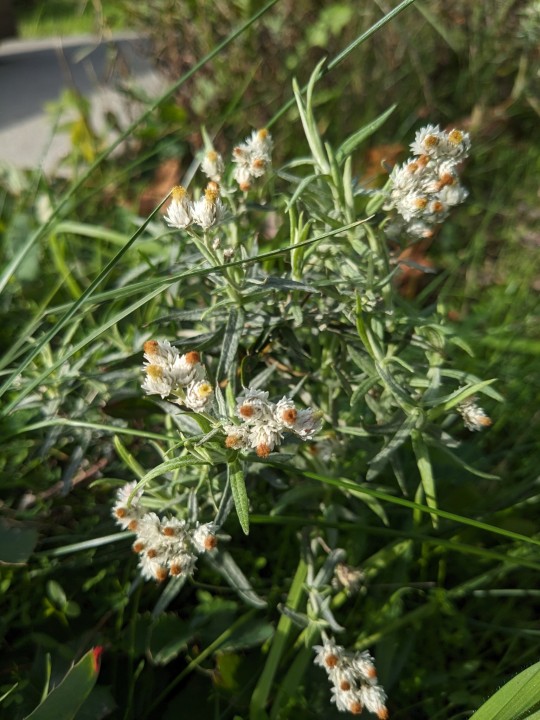
Pearly everlasting living up to its name by still being in bloom mid-october
14 notes
·
View notes
Photo
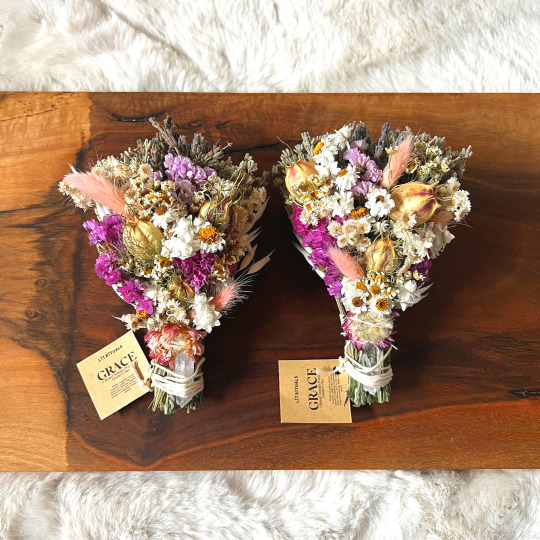
Grace Burn Wand by: Lit Rituals
133 notes
·
View notes
Photo

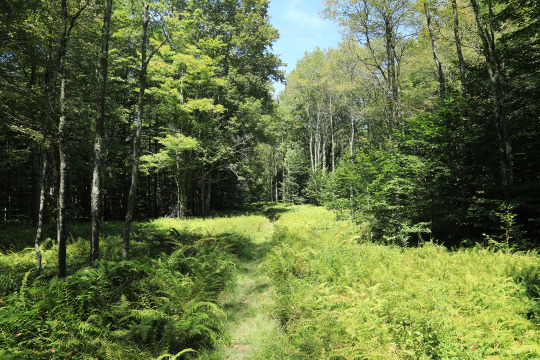
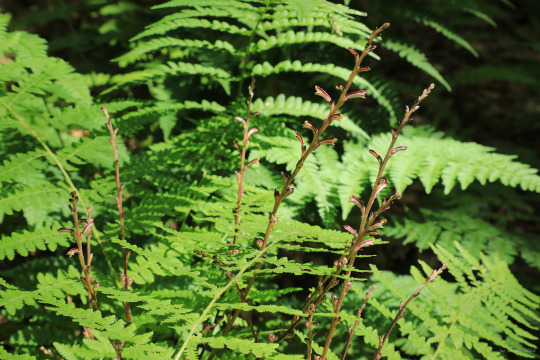

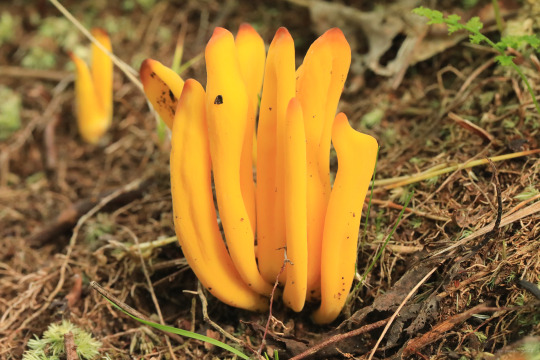

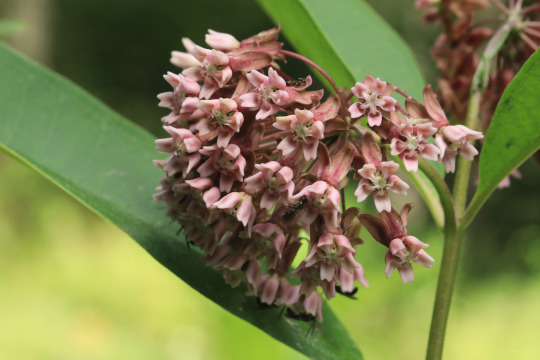

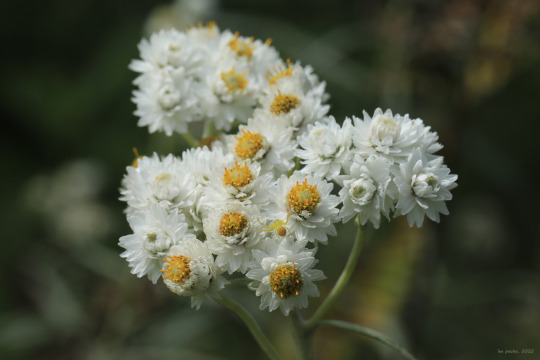

Canaan Valley National Wildlife Refuge, Part 1. Had Allegheny Power gotten its way 40 years ago, the land included as part of this idyllic refuge would today be the muddy bottom of a lake formed by damming the Blackwater River. The power company proposed turning the largest and most botanically-diverse high-elevation wetlands complex east of the Rocky Mountains into a “recreation destination” (e.g., overpriced tourist trap similar to nearby Deep Creek, Maryland) so it could execute a sketchy pump and release hydroelectric scheme. Thankfully, the US Army Corps of Engineers refused to issue a permit, and the nation has been since been rewarded with its 500th national wildlife refuge.
From top: beechdrops (Epifagus virginiana), a really unusual parasitic plant that draws its nutrients from the roots of the American beech tree; golden spindles (Clavulinopsis fusiformis), also known as spindle-shaped fairy club, a glorious late summer coral fungus; great spangled fritillary (Speyeria cybele), a common and lovely member of the Nymphalidae family that practically begs to be photographed; common milkweed (Asclepias syriaca), which blooms late into August at the higher elevation of the valley; Monarch larvae (Danaus plexippus), in their fifth instars; pearly everlasting (Anaphalis margaritacea), a fabulously-beautiful late summer aster much beloved by the dried flower industry; and the stingbean-like seed pods of Indian hemp (Apocynum cannabinum), one of the bittersweet bellwethers of summer’s end.
#appalachia#vandalia#west virginia#allegheny mountains#canaan valley#canaan valley national wildlife refuge#tucker county#epifagus virginiana#beechdrops#clavulinopsis fusiformis#golden spindles#spindle-shaped fairy club#speyeria cybele#great spangled fritillary#asclepias syriaca#common milkweed#danaus plexippus#anaphalis margaritacea#pearly everlasting#apocynum cannabinum#indian hemp#wildflowers#flora#summer
53 notes
·
View notes
Text
Lamb's Quarter

Find:cultivated fields, pastures, wasteland, roadsides, gardens and almost anywhere the soil is disturbed.
Description:Leaves are alternate, 1 to 4 inches long, up to about 2½ inches wide, variable in shape, diamond-shaped to egg-shaped to lance-elliptic in outline, pointed to blunt at the tip, wedge-shaped at the base, tapering to a stalk half to about as long as the blade. Lower leaves are largest, usually irregularly toothed, 1½ to 2+ times as long as wide, occasionally with a pair of very shallow lobes near the base (but usually not), becoming smaller and less toothy as they ascend the stem with the uppermost leaves often much narrower, proportionately longer, and toothless.Surfaces are green often turning reddish with age, hairless, moderately to densely white or pink-mealy especially when young, the upper surface usually becoming smooth, the lower surface usually remaining white-mealy. Stems are erect to ascending, unbranched to much branched, sparsely to densely white-mealy especially on the upper stem, and green to purple striped, sometimes purple at the leaf nodes.
Precautions:lambs quarters contain oxalic acid, which can be both a stomach irritant and can impede the absorption of calcium. Cooking eliminates most oxalic acid — but go easy if you choose to eat them raw.
Lilacs
(Not native but everywhere)

Find: yards,farms,feild and parks.
Description:This shrub is 8-20' tall, sending up multiple branching stems that form a vase-shaped crown. Stems at the base of this shrub are up to 8" across. The bark of large old stems is gray to gray-brown, somewhat rough-textured, slightly shredded, and sometimes shallowly furrowed. The bark of young stems is gray to brown and smooth, while new shoots are green and glabrous. Pairs of opposite leaves occur along the young stems and shoots. Individual leaves are 2-5" long and 1½-3½" across; they are cordate to ovate and smooth along their margins. The upper leaf surface is yellowish green to dark green and hairless, while the lower surface is pale green and hairless. The slender petioles are ½-1½" long, light green, and glabrous. Elongated panicles of flowers about 3-7" long develop from the stems of the preceding year. The panicles taper gradually toward their apices and they are ascending to erect. Individual flowers are about 1/4" (6 mm.) across and 1/3" (8 mm.) long, consisting of a narrowly tubular corolla with 4 spreading lobes, a short tubular calyx with 4 teeth, a pistil with a single style, and 2 inserted stamens. On different shrubs, the corollas can be purple, lavender, light blue, pink, or white, although lavender is the most common color. The branches of each panicle are light green and glabrous.
Edible Parts and uses:lilac blossoms are edible.Make into syrups,teas and wines.
Precautions:no real precautions.
Mallow-High

Find:grows in meadows, roadsides, disturbed sites and gardens.
Description:The flowers are funnel shaped or cup shaped, and usually pale pink, with each bloom having the five separate petals typical of all mallow varieties. It grows at least a metre and a half in height, is well branched.
Edible Parts and uses:leaves are edible raw.young leaves are more tender and less bitter than older leaves.young shoots are edible raw.leaves are suitable as a soup thickener.seeds are edible raw.seeds have a palatable, nut-like flavour.flower buds and flowers are edible.fruits are edible.
Precautions:Poisoning is caused by ingestion of high doses of nitrates (muscle weakness, nausea, vomiting, lack of coordination).
Mallow-Musk

Find:grows in meadows, roadsides, disturbed sites and gardens.
Description: is an ephemeral woody perennial. It has leaves of 5 to 10 cm whose musky odor has given its name to the plant. The upper leaves are pennatized - meaning finely cut. The flowers appear from June to October, in the shape of a flattened cup, with five petals, white or very pale pink.
Edible Parts and uses:leaves are edible raw.young leaves are more tender and less bitter than older leaves.young shoots are edible raw.leaves are suitable as a soup thickener.seeds are edible raw.seeds have a palatable, nut-like flavour.flower buds and flowers are edible.fruits are edible.
Precautions:Poisoning is caused by ingestion of high doses of nitrates (muscle weakness, nausea, vomiting, lack of coordination).
Common Milkweed

Find:fence rows, on roadsides, in fields, and in prairies and pastures.
Description:This is a tall and conspicuous species that sometimes forms large clones. The umbels bear large balls of pink to purplish flowers that have an attractive odor.Follicles split open in the fall and early winter dispensing wind borne seeds.
Edible Parts and uses:Although milkweeds are poisonous raw, the young shoots, leaves and seed pods are all edible cooked.
Precautions: Poisonous parts include milky sap from leaves, stems. Toxic only in large quantities. Symptoms include vomiting, stupor, weakness, spasms by ingesting other species; need careful identification.
Mint

Find:found in shaded areas, especially in moist soils, however their wide spreading rhizomes can collect moisture from a wide area. along rivers, lakes and streams, as well as shaded areas along the edges of forest and woodland.
Description:leaves and stems are generally hairy but these fine hairs can sometimes be absent. The leaves are elliptic, toothed and deeply veined. The flowers are arranged on spikes, filled with clusters of white, pink or purple petals.
Edible Parts and uses: leaves and stems.
Precautions:no real precautions.
Mullein
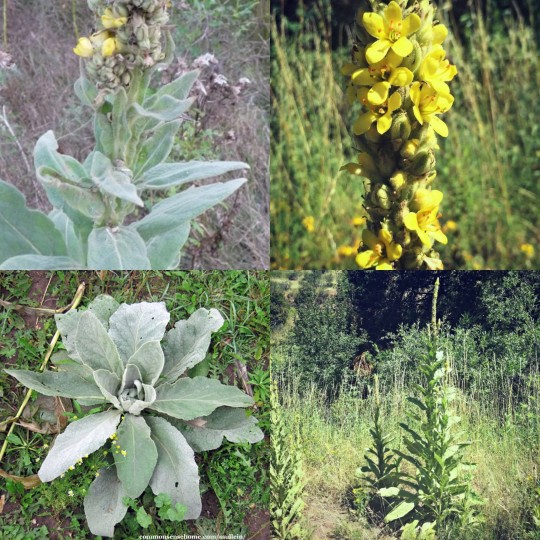
Find:Generally on open ground in disturbed soil.
Description:Biennial up to 2 m tall. Large pale green-grey, woolly, oval or eliptical leaves with winged stalks arranged in a basal rosette in first year. Flower spike in second year ends in a densely packed terminal spike occasionally with smaller side spikes. Flowers yellow with 5 petals. Fruit is oval capsule.
Edible Parts and uses:leaves and flowers are edible, enjoying a cup of tea made from these parts is generally preferable. Leaves and flowers can be used in a salad.
Precautions:The root, seeds and, to a lesser extent, the leaves of the plant, contain poisonous components.
Narrow-leaved purple coneflower
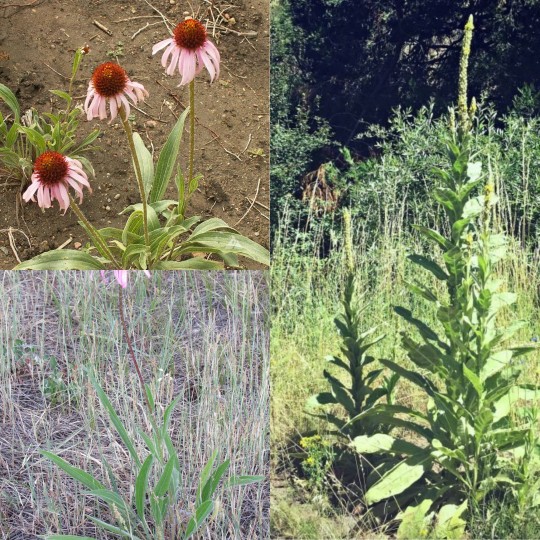
Find:is found in mixed grass prairies.
Description:Leaves are mostly basal, with stem leaves widely spaced and alternately attached on the lower half of the stem. Lower leaves are long and narrow, to 8 inches long, ½ to 1 inch wide, on long stalks, becoming smaller and stalkless as they ascend the stem. Edges are toothless and there are 3 distinct veins along the length. Stems and leaves are hairy and rough to the touch. Stems may be green or purple tinged.
Edible Parts and uses:Leaves and flower petals are edible. All parts of the plant have been used in tinctures or other medicinal methods.
Precautions:no real precautions.
Johnny jump-ups
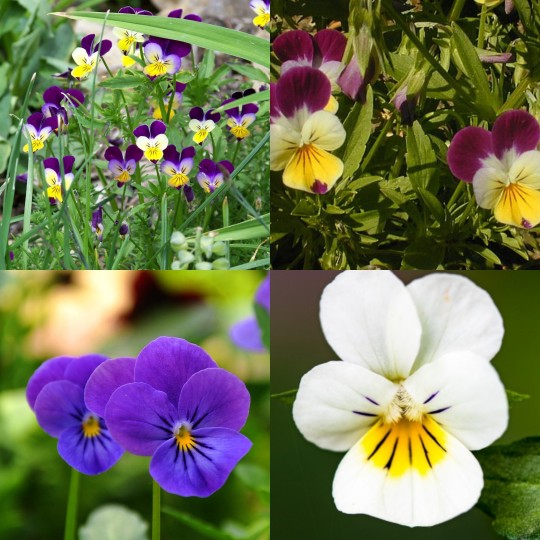
Find:Habitats include limestone glades, moist sand prairies, fields, edges of sandy paths, and waste places. Sandy areas with a history of disturbance are preferred.
Description:This wildflower is a winter or spring annual about 6" tall, sometimes branching near the base of the plant; it is more or less erect. The small basal leaves have orbicular blades with long slender petioles; these are followed by alternate leaves along the stems. The stems are lightgreen to purplish green and hairless.
Edible Parts and uses:flower petals.
Precautions:no real precautions.
Pearly Everlasting

Find:growing in sunny locations althoughtit can be found in part shady areas as well. It likes dry fields, along roadsides, disturbed soils, and the edges of wooded areas.
Description:This plant is easily recognizable; it has small white button-like flowers with yellow centres. It forms a bushy mound of hairy silver-gray foliage but the flowers are easy to identify. One salient feature is that the undersides of the leaves are covered in tiny hairs, giving them a woolly feel and appearance. The stems are dry and brittle.Pearly everlasting flowers are generally flat-topped clusters of numerous 0.5cm to 1cm (¼ to 1/3”) flower heads at the top of the plant.
Edible Parts and uses:flowers in tea.Young leaves are edible when cooked.
Precautions:no real precautions.
#lambs quarter#lilacs#Mallow#musk mallow#common Milkweed#Milkweed#mint#herbs#mullein#coneflower#Johnny jump up#pearly Everlasting#foraging#cottagecore#homesteading#plants
24 notes
·
View notes
Text
Pearly
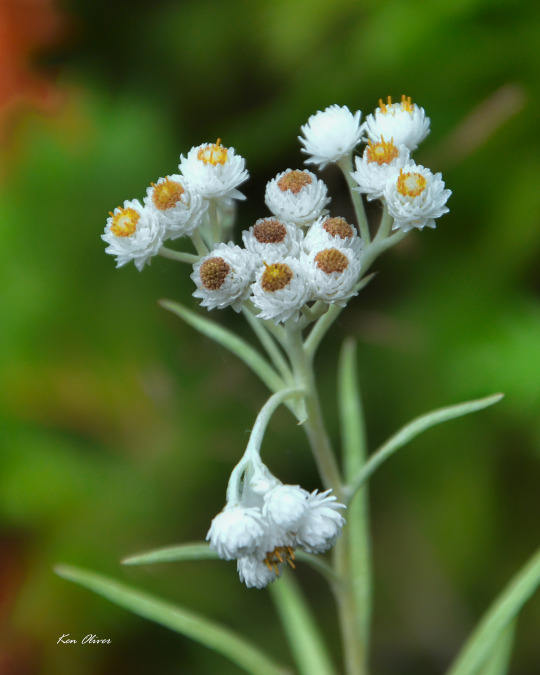
Anaphalis margaritacea (Pearly Everlasting)
©2022 Ken Oliver
#original photographers on tumblr#photography#nature#photographers on tumblr#nature photography#original photographers#original photography on tumblr#wildflowers#macro#pearly everlasting
8 notes
·
View notes
Photo
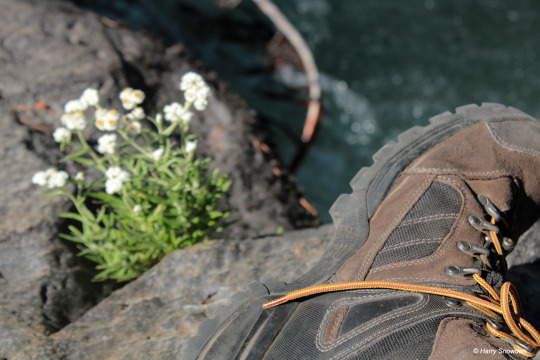
Self Portrait 2022 - with Pearly Everlasting
#pearly everlasting#photographers on tumblr#pnw#oregon#Rogue River#wildflowers#hiking#self portrait#2022#late summer#high cascades
2 notes
·
View notes
Photo

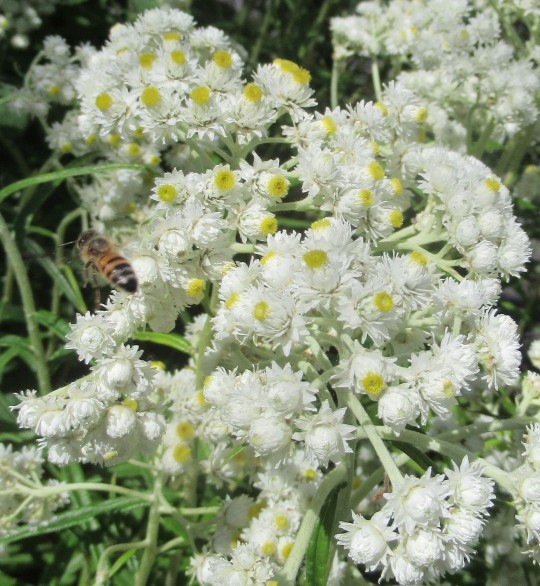
Anaphalis margaritacea (Pearly everlasting) and Apis mellifera (Western honey bee)
The Waggle Dance
In 1927, Karl von Frisch published a book called “The Dancing Bees”. In 1973, he won the Nobel Prize for deciphering the meaning of the Western honey bee’s ‘waggle dance’. When a honey bee finds a rich source of nectar, it returns to the hive and gives a little taste to a group of worker bees. Once it has assembled a crowd it does the ‘waggle dance’. The other bees then fly directly to the food source.
Frisch figured out that the direction of the dance indicates the direction of the food source and the duration of the dance shows the distance. He went on to discover that bees see in color and can understand simple geometric shapes. It is likely that this information is also communicated. Of the 16,000 known species of bees, only the Western honey bee demonstrates this behavior.
#tiny flowers#photographers on tumblr#pearly everlasting#honey bee#Karl von Frisch#fleurs#flores#fiori#blumen#bloemen#vancouver
79 notes
·
View notes
Photo

Portland Landscape Mulch
Inspiration for a mid-sized contemporary shade backyard mulch landscaping in summer.
#native woodland backyard#pearly everlasting#wetland grass#backyard retreat#wetland flowers#native planting#woodland
0 notes
Text
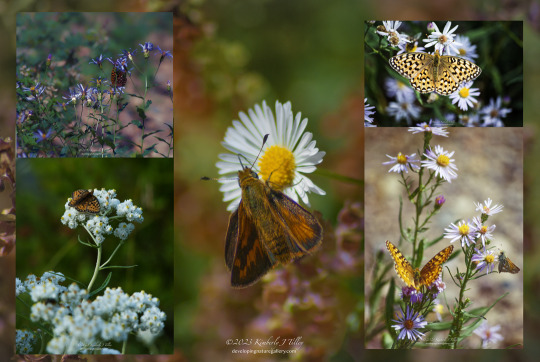
Four fritillary and two skipper butterflies have been added to the BUTTERFLIES folder at developingnaturegallery.com. These five photographs were taken in the western landscape; on trails and in a garden.
#butterflies#insects#bugs#wildflowers#asters#white#purple#orange#yellow#green#garden#nature photography#pearly everlasting#summer#kimberlyjt#developingnature#woman photographer#shoponline#shopsmall#supportsmallbusiness#supportanartist#giftideas#coffee mugs#coasters#posters#wallart#decor#puzzles#buttons#magnets
0 notes
Text

𝟷𝟾𝟽𝟷 𝙵𝚊𝚛𝚖𝚑𝚘𝚞𝚜𝚎
#farmhouse#simple#dried flowers#decor#white#neutral tones#flowers#pearly everlasting#grain sack#cottage
1 note
·
View note
Text
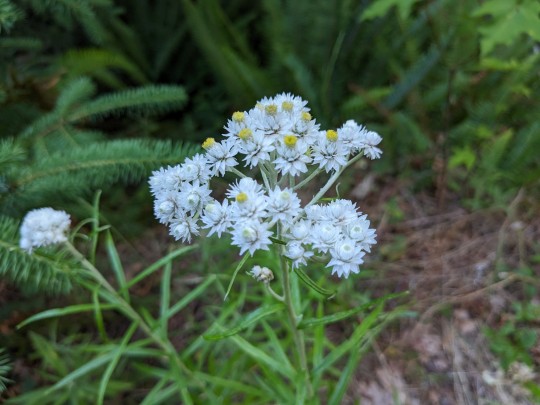
Anaphalis margaritacea was prettier in the wild than the pictures i had seen led me to believe!!!
12 notes
·
View notes